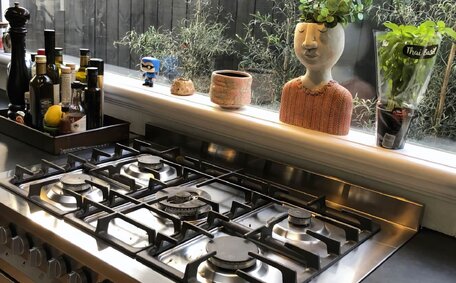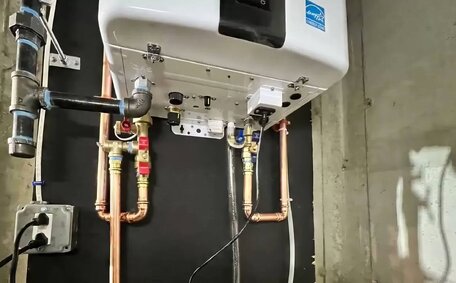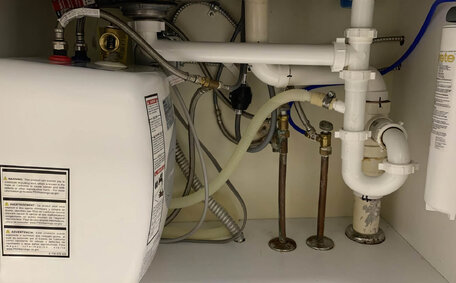Understanding Why Pipes Freeze
Pipes freeze in below-freezing temperatures as water expands upon freezing, creating immense pressure inside the pipe. In fact, a burst 1/2-inch copper pipe can spew up to 250 gallons of water per hour under 40 to 60 pounds per square inch of pressure.
Several factors cause pipes to freeze more readily:
- Exposure to cold air. Pipes running through unheated areas like basements, attics, or garages are more prone to freezing.
- Lack of insulation. Bare pipes, which can cause pipes to freeze, lose heat more quickly.
- Cold water temperature. Pipes containing very cold water reaching below freezing are more likely to ice up.
- Pipe material. Metals like copper and cast iron freeze more readily than plastic.
- Water pressure influences freezing points; lower pressure may alter the temperature at which water freezes.
- Poor circulation. Stagnant or frozen water is more likely to freeze than moving water.
To protect your home from frozen pipes, it’s crucial to insulate exposed piping, maintain steady heat, optimise water pressure, and swiftly repair drafts.
Exposure to cold air. Pipes running through unheated areas like basements, attics, or garages are more prone to freezing.Knowing the Signs of Frozen Pipes
Various signs like strange noises or no water flow may indicate water freezing within your pipes:
- No water flow implies that water may be frozen within the pipes, signaling a problem. Understanding that a frozen pipe can cause significant water damage is the most obvious red flag.
- Pipes feel much colder to the touch than normal.
- Unusual banging or loud clanking noises can sometimes be heard, a sign that you might need to thaw your frozen pipes, as they expand and contract.
- Low water pressure or intermittent interruptions to flow.
- Icicles forming on indoor plumbing fixtures.
- Frost on the exterior of pipes.
In the Sydney area, your home older than 1960 is especially prone to freezing in winter since old galvanised steel or cast iron pipes often lack sufficient insulation. Knowing where your water lines run, like in unheated crawl spaces, along exterior walls, or through the attic, can help pinpoint problem areas.
If you suspect a frozen plumbing system, contact a local plumber immediately to mitigate the situation before pipes burst.
Taking Preventative Measures
There are numerous things homeowners can do to prevent freezing pipes before winter sets in, thus sidestepping potential bursts:
- To safeguard your plumbing, insulate pipes in unheated spaces such as attics, crawl spaces, and garages using foam, sleeves, or heat tape. This action shields the plumbing, as it’s understood that pipes can also suffer damage from cold exposure without proper insulation.
- Seal leaks and drafts around windows, doors, vents, and openings to keep your house cosy, which does not allow cold air into the infrastructure where pipes reside.
- By disconnecting and fully draining your hose, you significantly lower the risk of water freezing and the resulting risk of burst pipes. Water left in the system can cause pipes to freeze and expand, possibly resulting in cracked faucets or pipes.
- Maintain a consistent indoor temperature of at least 13°C during cold periods, even when absent. Programmable thermostats can assist in temperature regulation.
- Turn your taps on to allow a slow drip during sub-zero temperatures, preventing water from freezing within pipes.
- By opening cabinet doors below sinks, you support running water through the system and prevent cold air from chilling plumbing in exterior walls.
- Warm up your water heater and insulate the pipes leading into your exterior faucets. Consider relocating water heaters away from exterior walls if possible.
- It is essential to know how to shut off your water at the main valve in case of pipe bursts. Ensure that every member of the household is aware of where your stopcock is situated to turn the water off promptly if needed.
Pre-emptive measures are critical to prevent pipe freezing and bursting. Ensure you maintain proper heat, insulation, draft sealing, and water circulation within your home’s pipes.
Insulating Pipes
Thoroughly insulating your water pipes is pivotal in preventing freezing by reducing heat loss. There are several effective types of pipe insulation to consider for homes in the Strathfield area:
- Pipe insulation tubing - Pre-slit foam tubes that slide snugly over pipes providing excellent thermal insulation. Easy to install on straight runs of pipe.
- Pipe wrap - Flexible foam sheets that wrap around pipes and insulate using an adhesive closure. Good for covering valves, elbows, and fittings.
- Fibreglass insulation - Works well to insulate pipes when protected by a vapour barrier. Helps stop air infiltration.
To properly insulate pipes:
- Clean pipes so insulation adhesive adheres properly.
- Measure and cut insulation to fully cover all exposed pipe.
- Seal seams and connections with insulation tape, a measure to prevent gaps.
- Use hangers and spacers designed for insulated piping.
Ensure access to valves and fittings for servicing. Insulating water lines before winter is a critical action to prevent pipes from freezing and bursting. Ensuring proper insulation thickness and sealing seams is key for getting it done right when creating a protective barrier against cold penetrating pipes.
Maintaining Heat
Keeping your home heated to at least 55°F (13°C) is crucial for preventing pipes from freezing during the winter months. If you plan to be away during winter, it’s essential to maintain adequate heat through steps like:
- Setting your thermostat to 55°F or above.
- Installing a programmable or smart thermostat that regulates your heating system temperature automatically.
- Arranging for a house sitter to monitor and adjust heat as needed.
- Utilising a space heater adds warmth to uninsulated areas, decreasing the risk of pipe freezing.
Keeping your heat on, even at a lower temperature, significantly reduces the risk of pipes freezing. Prolonged exposure to subfreezing indoor temperatures can chill the water inside pipes to the point of freezing. Managing how to keep your home’s temperature ensures pipes remain warm enough and water flows freely all winter long.
Sealing Drafts
Sealing up any cracks, openings or penetrations in your home’s exterior is crucial for preventing cold outdoor air from infiltrating and freezing pipes. Exposure to drafts can dramatically reduce temperatures and lead to frozen water pipes.
Employ caulk and weatherstripping to seal gaps, which helps insulate pipes from potential freezing should water ingress near windows, doors, vents, and electrical openings. Pay special attention to areas where pipes located in spaces such as basements, crawl spaces, attics, and garages are at higher risk. Cover vents and openings with insulation or plastic sheeting.
Carefully inspect for gaps and cracks inside closets, behind cabinets and around pipes in exterior walls. Look for daylight shining through and use incense sticks or your hand to check for drafts. Thorough sealing helps stop cold air from reaching pipes.
Sealing all cracks and openings ensures a protective envelope around your home’s piping system. Combined with proper insulation and maintaining heat, draught proofing helps prevent freeze damage.
Checking for Leaks
Regularly inspect your plumbing for minor leaks to prevent them from escalating to severe issues like frozen pipes. Look for the following signs of leaks:
- Higher than normal water bills
- Musty odours coming from hidden areas
- Discoloured water
- Sounds of running water when all fixtures are off
- Visible dripping from pipes, valves, joints etc.
Conduct inspections along all accessible water lines, joints, valves and fittings. Look for moisture, rust, mineral deposits or water stains which indicate small leaks. Use a mirror to inspect difficult to reach areas.
Leaks enable air entry, cooling the water within the pipes and increasing the chance of freeze-induced bursts. Even small drips can gradually reduce pressure, raising the freezing point, which could eventually lead to a freeze burst. Fixing leaks also improves water efficiency.
Annual leak inspections ensure problems are caught early before pipes freeze and burst, preventing major water damage.
Identifying and Thawing Frozen Pipes
If you suspect pipes are frozen, the first step is to identify which sections are impacted, then call plumber if necessary. Start by checking pipes in unheated areas like attics, crawl spaces, basements, and exterior walls. Feel along pipes to locate cold spots - You’ll notice a pipe frozen solid by its significantly lower temperature to the touch.
After identifying a frozen pipe section, here are several safe methods to thaw it effectively before seeking professional help:
- An electric heating pad enveloping the affected pipe section can efficiently thaw it with consistent, gentle warmth.
- You can also Apply heat by wrapping pipes with towels soaked in hot water, changing them when they cool.
- Use portable space heaters or lamps to warm areas affected by do frozen pipes, including tanks, and other appurtenances.
- Pour warm (not boiling) water over the frozen area to gently thaw the pipe, ensuring no water escapes uncontrollably while capturing the runoff.
- Use a hair dryer on its lowest setting to gently turn water to liquid within frozen pipes.
- Open cabinet doors below sinks to let warm air circulate and prevent the cold from affecting the pipes.
When thawing pipes, avoid dangerous methods such as using open flames or torches. Once you successfully thaw a pipe, turn taps on slowly and wait until full water flow is restored to ensure the water runs properly. Acting swiftly to do frozen pipes thawing can prevent cracks and bursts.
Handling Frozen Pipe Emergencies
If you discover frozen pipes, the first step is to shut off your home’s main water supply. locate and turn off water using your main shutoff valve (usually near the water metre) by turning it clockwise to stop water flow.
Ensure you know where to turn off power to your boiler to avoid damage.
Our experienced, licenced plumbers are available 24/7 to quickly assess the situation and take necessary action. Avoid serious flooding by calling us promptly before enduring permanent damage from frozen pipes.
With preventative maintenance and emergency services, Strathfield Plumbing keeps your plumbing running smoothly all winter. Learn more about how to prevent frozen pipes or get expert help during critical situations by contacting us today.
Repairing Burst Pipes
When pipes burst, it is crucial to act quickly to minimise water damage. The first step is to locate and turn off the home’s main water valve to turn off water supply completely. If unable to access the main valve, turn off individual fixture valves.
Relieve water pipe pressure, an action you can take by turning on the highest faucet in the home. Catch any released water in a bucket or pan. Once water ceases flowing, turn off the faucet immediately to minimise the impact and cut off main water if a pipe bursts.
Examine all pipes to identify the source of the leak. Burst pipes will likely need to be replaced. Copper and PEX pipes can be spliced by installing couplers over damaged sections.
For DIY repairs, use pipe clamps as a temporary patch until a new pipe length can be spliced in.
For more intricate fixes, ensure to reach out to a licensed plumber well-versed in pipe restoration. Professionals have the tools and expertise to fully replace burst pipe sections and restore proper water flow throughout your home’s plumbing system.
Dealing with Water Damage
Promptly remove damp items like carpets and furniture to avert mould growth. Promptly contact your insurance agent to discuss filing a claim for repairs and property damage. Hire a water damage restoration company to extract standing water and dry out affected areas. Hire a water damage restoration company to extract standing water and dry out affected areas.
Position buckets beneath drips to collect water. Document all damage with photos for insurance claims.
Knowing When to Call a Professional
Professional help is often necessary when addressing frozen or burst pipes. Plumbing issues can quickly escalate into complex problems beyond a DIY fix. Calling in a licenced plumber is advisable when:
- You are unable to locate or access the main water shutoff valve
- Pipes have fully burst and are gushing water
- The source of leaks or bursts is not readily identified
- Pipes fail to thaw after DIY attempts like applying heat
- Significant water damage has occurred and restoration is needed
- Sections of pipe require full replacement or re-routing
- You lack the skills, tools or time for comprehensive repairs
The experienced plumbers at Strathfield Plumbing are available 24/7 for frozen pipe emergencies. We can promptly assess situations and implement solutions to get your water flowing again and repair damage. Don’t hesitate to call our team for urgent assistance.
Ongoing Pipe Maintenance
Preventing frozen pipes necessitates year-round diligence and maintenance. Here are some best practises:
- Inspect exposed pipes monthly for signs of leaks, corrosion and insulation damage. Make repairs right away.
- Check that pipe insulation meets recommendations - at least 1 inch for most pipes. Replace if degraded.
- In fall, ensure vents and openings are sealed to prevent cold air infiltration.
- Test plumbing shutoff valves to ensure proper operation in an emergency.
- By keeping your system’s gutters and downspouts clean before winter, you ensure melting snow drains as intended.
- Disconnect outdoor hoses and irrigations systems ahead of freezing weather.
- Trim back vegetation that could limit air circulation around pipes.
- Replace inefficient plumbing fixtures that leave pipes exposed to freezing risks.
- Have a plumbing professional inspect pipes, fittings, insulation and shutoff valves annually to identify problems.
Regular maintenance ensures your plumbing system is well-prepared to endure freezing conditions. Contact the licenced professionals at Strathfield Plumbing on 1300 349 338 to schedule annual pipe inspections and other preventative maintenance services.






